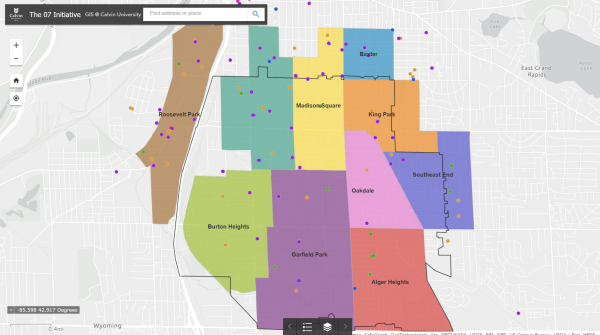Diesel fuel found leaking into Plaster Creek
A Kentwood resident called 911 on Tuesday to report the smell of diesel fuel coming from Plaster Creek. The firefighters and engineers who responded to the call discovered that the source of the leak was the property of Sweet Express, a Kentwood trucking company.
The Kentwood fire department could not determine exactly where at Sweet Express the diesel fuel was coming from, and authorities are unsure how much fuel has leaked into the creek or for how long it has been leaking.
The site of the reported leak is less than four miles from Calvin’s campus, near the intersection of Breton and 32nd Street.
The fire department has taken steps to begin collecting the fuel and Young’s Environmental, an environmental emergency response contractor, was hired to clean up the leaked fuel.
The quick response to the fuel spill heartened Gail Heffner, co-founder and co-director of Plaster Creek Stewards.
“I really appreciate that a resident smelled the fuel and called 911 to do something about it. … It shows people care about the creek and are paying attention to it,” Heffner said. One of the missions of Plaster Creek Stewards is not only to educate and inform neighborhoods about their watershed, but also to help develop relationships between the community and the creek.
Plaster Creek is considered the most polluted creek in Michigan. The creek has levels of E. coli 50 times higher than is recommended for safe body contact.
“People shouldn’t wade or even touch the water [in Plaster Creek],” Heffner said.
Since the Clean Water Act of 1972, it has been illegal to dump waste in any body of water. But as Heffner and Stephanie Bradshaw, president of the Environmental Stewardship Coalition (ESC) at Calvin, both explained, runoff after rainstorms continues to channel pollutants from the watershed into the creek.
Urban development has left fewer and fewer green spaces to absorb water. As a result, when it rains, excess stormwater runoff from urban Grand Rapids triggers the problems that plague urban watersheds.
Typical problems include erosion of streambanks which lead to soil and sediments flowing into creeks and bacterial contamination from fertilizers. Thermal pollution is also problematic; water heats up as it travels over the heated concrete of roads and rooftops before entering bodies of water, and this warmer water damages aquatic species living in creeks and streams.
Residents’ lack of knowledge about water flow in the watershed doesn’t help.
In Grand Rapids, the sanitary drain and storm drain systems are separate. While sanitary drains route their contents through sewage treatment before they reach the river, the storm drains do not.
“Anything that’s in the roads can end up in the creek,” Bradshaw explained. This includes fuels and mechanical fluids from cars, as well as pesticides and herbicides carried from lawns into the drains.
Though the magnitude of the diesel fuel spill is unknown, what’s in the water in Plaster Creek has repercussions for the water quality of the whole region.
“Everything that happens in the Plaster Creek watershed drains into Plaster Creek, which drains into the Grand River, which drains into Lake Michigan, which is where we get our drinking water,” Heffner explained. “What we do has an effect on those downstream from us.”
The Environmental Stewardship Coalition works with Calvin’s Plaster Creek Stewards to mitigate some of the ongoing pollution in the watershed. ESC students volunteer twice a year with Plaster Creek Stewards, in addition to participating in the annual Grand River Cleanup hosted by the mayor. Typically, those efforts are directed towards reducing storm drain flow into the river by installing rain barrels and planting rain gardens.
Bradshaw also noted that pesticides, herbicides, engine oils and other fuel can be disposed of at the Kent County Hazardous Waste facility, where they will not further pollute Plaster Creek.








